I'VE always been captivated by books and magazines that depict artists, or their models and tools, on their covers and interiors.
I suppose I'm drawn to the stark romanticism of these scenes, but I also know it's a form of wistfulness based on my regret for not fulfilling an ambition to become a professional illustrator when I was young and determining career choices.
I suppose I'm drawn to the stark romanticism of these scenes, but I also know it's a form of wistfulness based on my regret for not fulfilling an ambition to become a professional illustrator when I was young and determining career choices.
I've been collecting these types of images for a long time and have amassed so many examples of this enchanting sub-genre that I thought it would be fun to feature them in a series of posts based on their publishing chronology. So here's the inaugural one, representing 1930's:
Imagine Russell Haviland Tandy in his studio in the year 1930. He gets a call from his friend, the juvenile series publisher Edward Stratemeyer: "I'm sending over a new girl for you to paint. You'll love her. She's perfect!" he proclaims, practically gushing over the phone. Soon, there is a knock at the door and in walks... Nancy Drew!
The Girl in the Flat Top; or, The Daughter of an Artist was published by Cupples & Leon of New York in 1930. May Hollis Barton is a house name, used on 15 juvenile titles. The actual author is not known. The dust jacket scene though could be a fanciful re-creation of the day Tandy was given the Nancy Drew assignment. Both the The Girl in the Flat Top and The Secret of the Old Clock were painted in the same year, and in actuality, with the same model: Grace Horton, a member of the once-famous Horton Ice Cream family. In truth, Tandy had already been painting Grace's sophisticated image on previous Barton books, so apparently she was the perfect choice to be become the world's most famous teenager.
Bertha M. Clay was the pen-name of prolific English author Charlotte Mary Brame, who wrote approximately 130 romantic novels during her all too brief lifetime. After her death in 1884 at the age of 48, her publisher continued to use her pen-name as a house name and ran off approximately three hundred more titles, making Bertha M. Clay perhaps the most widely read British author in the United States at the turn of the 20th Century. Married for her Beauty, or a Bitter Atonement appears to have been published first in 1876, and then reissued by Ward, Lock in 1930. Ward, Lock used a dozen or so of the same artists from the 1920s through the 1960s, but so far I haven't been able to determine which one of them painted this jacket illustration.
'The tragic death of her beloved father, an artist and beauty lover, casts lovely, innocent Diane Balfour into the care of the dire, mone-loving farmer, Bruno Severne, and their marriage arouses the indignation and enmity of his sister, Hester, In desperation Diane runs away and abroad finds a new life and her soul mate. Rather than lose her lover she conceals the fact that she is already married and enjoys a wonderful spell of happiness until fame her beauty again lead to tragedy and heart-break. In this novel Bertha M. Clay tells a deeply moving story of human suffering, desperation and remorse.'
Edith Ballinger Price (1897-1997) was a prolific American writer and illustrator of children's books. She was the granddaughter of landscape painter William Trost Richards, who inspired her to draw. She studied at the School of the Museum of Fine Arts in Boston, the Art Students League in New York City, and the National Academy of Design in NYC. She produced work for Colliers and St. Nicholas Magazine, among others, and was one of the chief founders of the Brownies, the junior version of the Girl Scouts. Price authored their first handbook, and drew many Girl Scout and Brownie related illustrations for a variety of purposes. The Fork in the Road was written by her and published by Century Company in 1930. She also created the jacket art. It is the romantic story of two "dissimilar twin sisters who meet two intelligent young men" (as opposed to cretins, I guess), and it all ends well, supposedly.
The Three Marys by Frederick Niven was published in hardback in the UK by Collins in 1930. It is the supposedly dramatic story, or maybe romantic story, of a celebrated portrait painter, in particular his relationships with three separate "Mary's" with whom he falls for. It was reviewed amusingly at The Dusty Bookcase, a Canadian blog that I like to visit. The wonderful jacket art depicting three diminutive women, each dressed according to their probable socio-economic status, was unfortunately not credited.
Neysa McMein was born Marjorie Frances McMein in 1888 in Quincy, Illinois. She attended The School of the Art Institute of Chicago, and later the Art Students League of New York. One of her first jobs was at a millinery firm, where she quickly became lead designer. After a brief stint at acting she turned to commercial art, adopting the name Neysa because she thought it would further her career. McMein always considered herself just an illustrator but in fact she was as good an artist as there ever was. In addition to painting the portraits of many famous people, from presidents to actors to writers, she painted posters and postage stamps, created the image of Betty Crocker for General Mills, and produced hundreds of magazine covers and interior illustrations. McCall's was one McMein's major clients, and from 1923 through 1937, she created all of their covers. The above issue is from June, 1932, and it is a self-portrait. McMein also lived for seven years at the famous Hotel des Artistes on West 67th Street in New York City. The parties she threw there are the stuff of legend.
John La Gatta (1894-1977) was an incredibly successful advertising and magazine artist during the Great Depression, sometimes earning as much as six figures per year, a staggering sum for the time. His specialis was beautiful women, and he cultivated some
of the best looking women in modeling, sometimes painting them for years
at a stretch. Fellow illustrator Frederick R. Gruger remarked that La
Gatta painted "chrome-plated women." But when magazines began phasing out illustration in favor of photography, La Gatta's income plummeted, so he turned to teaching and portrait painting to get by (one assumes he didn't invest his money wisely). As an art teacher he was instrumental in guiding students such as Bart Forbes, Mark English, Bob Peak and Don Shaeffer to their Hall of Fame heights. This issue of The Saturday Evening Post was published on September 9, 1933. The medium is charcoal sprayed over with fixative and then embellished in oil paint. An interesting anomaly is that the eyes in the painting are brown while on the magazine cover they're blue (plus her cheeks are rosier).
Harry Lemon (H. L.) Parkhurst (1876-1962) was a pulp magazine cover artist and comic book illustrator for most of his life, producing moody, sexy work like the kind seen on the October, 1933, issue of Complete Detective Novel. He started out like so many other artists of his ilk by working for newspapers and in advertising. Parkhurst is sometimes confused with another artist named Harry Landon Parkhurst, but the two are definitely not the same person.
Enoch Bolles almost patented good-girl-art continues to stand the test of time as far as collectibility is concerned. Pin-ups seemed to be his specialis, but he also produced scores of magazine covers, including more than two decade's worth of work for Film Fun magazine. This issue was published in November, 1931. What bothers me specifically about his "girls" is that too many of them come across as way too young--and that just seems creepy to me.
Painting probably came naturally to Oscar Greiner (1900-1976); both his father and his sister were commercial artists too. Greiner tended to specialize in cover art for the "saucy" pulps during their heyday, but he also produced cover art for other genres including motion-picture magazines; in fact, he was Shirley Temple's exclusive portrait artist during her famous film career. La Paree Stories was an "entertaining fiction" magazine aimed at adults that ran monthly from 1930 until 1938. This issue was published in November, 1930.

Earl Kulp Bergey (1901-1952), or Earle Bergey, as he habitually signed, was one of the most prolific illustrators of his generation, painting literally hundreds of pulp magazine and paperback covers. His early pulp artwork was mostly cheesecake portraiture commissioned by "entertaining fiction" magazines like Snappy (top), which began publication in 1912, and ran for 21 years before ending one month after this November issue came out, in December, 1933. The bottom cover is the November, 1936, issue of La Paree, with cover art by Earle K. Bergey.
 |
| CLICK ON IMAGE TO ENLARGE |
These two charcoal pencil illustrations are by master illustrator and cartoonist Raeburn Van Buren (1891-1987). It was suggested that these were probably story illustrations for the Saturday Evening Post, in either 1933 or 1934, but I could not locate them in any issue surrounding those years. Van Buren, or Ray, as he was usually addressed, was a World War I veteran, and one of the industry's top freelance illustrators in his day, contributing work to a wide variety of popular publications; the New Yorker, Collier's, Esquire, Redbook, McCalls, and of course the SEP. However, he is best remembered for illustrating the syndicated newspaper cartoon Abbie an' Slats, from its inception in 1937 by cartoonist Al Capp, to its final year in 1971, when Van Buren took his retirement.
William T. Aldrich (1880-1966) was a noted Boston based architect, earning a degree from MIT in
1901, but he was also a prolific fine arts watercolor painter and impressionist. He was credited with producing this colorful dustjacket for Ann Bridge's contemporary romance novel Illyrian Spring, which Little, Brown published in 1935. Aldrich's paintings, always broad in subject matter, are represented at several museums, including the Whistler
House Museum of Art in Lowell, MA, the
Fogg Art Museum at Harvard University, and the Museum of Fine Arts in Boston, MA.
This glowing jacket art was painted by John J. Floherty, Jr. (1907-1977), who emigrated to the U.S. from Ireland when he was just 20 to study at the Art Students League and the Grand Central School of Art. After that he became a journalist, photographer, public relations man, art and editorial director, sailor, world traveler, paperback and hardback cover artist, and eventually an author of over 40 books for young people. During World War II he was also a combat artist at Iwo Jima and Okinawa but was barred from actual military duty because he had only one working eye, the other eye lost at age 14 in a sporting accident.
Oxford educated Englishman James Laver (1899-1975) wrote numerous books on the history of costume and stage plays and also a few novels, among them Background for Venus, which Knopf published in hardback in 1935. Laver also acted as Keeper of Prints, Drawings and Paintings for the Victoria and Albert Museum between the years 1938 and 1959.
Oxford educated Englishman James Laver (1899-1975) wrote numerous books on the history of costume and stage plays and also a few novels, among them Background for Venus, which Knopf published in hardback in 1935. Laver also acted as Keeper of Prints, Drawings and Paintings for the Victoria and Albert Museum between the years 1938 and 1959.
John Newton Howitt (1885-1958) began his professional art career in 1907 after graduating from the Art Students League. He produced a significant body of work doing portraits, landscapes and advertising art, but he is best remembered today for his many magazine interior illustrations and covers. They ran the gamut from the "shudder" pulps to the Saturday Evening Post. Howitt's "Painting A Polar Bear In Summer", a probable self-portrait, was rendered in 1935 for an unknown magazine story.
All-Story Love Stories magazine was first published in 1929, and ran weekly, then monthly, until 1957. That's a lot of issues, and stories, too many to try and calculate. The top cover was published in September, 1934. The bottom cover in November, 1935. I like the bottom cover so much that if I had a clean image of the original art I might consider it for use as my blog header. Neither cover is signed but there's a slim chance that they are the work of pulp illustrator Charles D. Williams, known also as C. D. Williams.
Portrait of the Artist's Children is a novel about an artist who eschews his too-perfect wife for his favorite model. It was published by Lothrop, Lee and Shepard Co., of Boston in 1935, who after 1940 became an almost exclusive publisher of books for children. The jacket art and design are the work of Clayton Rawson (1906-1971), a noted illustrator, crime writer and performance magician.
Edward Charles is a nom de plume of Englishman Edward Charles Edmond Hemsted (b. 1898, date of death unknown). He was educated at Lancing College, St. John's College, and also at Oxford and then taught at the Imperial Japanese Naval College on Jadrishar Island. As a teacher and English Professor he was often recognized for lecturing his students as if they were his own age. Charles was also a librarian and editor at Toynbee Hall (London) and was keen on poetry, especially the Romantics. During his varied career he wrote several books including Those Thoughtful People (1930), Apple Pie Bed (1931), Men Gods (1931), Sand and Blue Moss (1931), Indian Patchwork (1933), Muscara (1934), and Idle Hands (1936), but he is best remembered for writing The Sexual Impulse (1935), a highly controversial, explicitly illustrated treatise on human sexuality which was the subject of a prosecution under U.S. Obscenity Laws.
Norman Blaine Saunders (1907-1989) is considered by some to be the greatest pulp artist of all time. What he really is, is the most prolific pulp cover artist of all time. Saunders produced 867 pulp magazine covers during his career, which is purportedly the most that any one artist has ever painted! His cover art representing John L. Tiernan's crime thriller Whip of Death, the featured story in the January 1936 issue of Black Book Detective, is a colorful early example of his vibrant style.
This cover is credited to Blaine, which of course is Norman Saunders' middle name and his most oft-used pseudonym. Saucy Stories, labeled Saucy Stories Digest on the contents page, published only seven issues, beginning in October, 1935, and ending in April, 1936, though they are linked thematically to the entire run of Saucy fiction magazines which began publication in 1916.
Screen Scandals consisted of four issues and they were published in May, June, July, and August of 1936. After that the fiction-oriented magazine changed its title to French Scandals and seven more issues were published. All of the covers are amazing but the artists have never been identified that I know of, but a good guess might be Oscar Greiner, who produced scores of these types of magazine covers in the Thirties.
I asked an art teacher once about easels that are tipped slightly
forward: his answer--so your brush doesn't drip unwanted paint onto the
canvas. Makes sense! Joseph van Abbey painted this jacket art with its forward leaning easel for the novel Ivor's Chance. It was published by Ward, Lock & Co., in 1936. Abbey, along with his brother Salomon, were prolific illustrators of jacket art on hardbacks, numbering well into the hundreds. To distinguish between the two, who both signed as Abbey, Joseph looped his letter y, and Salomon used a straight line for his.
Not much is known about author Paul Trent, who was born in England as Edward Platt in 1872 and died in London in 1946. He was a magazine short story writer before becoming a prolific novelist, and mystery writer. His series detective is Peter Quayle of Scotland Yard, who starred in several of his mysteries. Ward, Lock was apparently his primary publisher.
Not much is known about author Paul Trent, who was born in England as Edward Platt in 1872 and died in London in 1946. He was a magazine short story writer before becoming a prolific novelist, and mystery writer. His series detective is Peter Quayle of Scotland Yard, who starred in several of his mysteries. Ward, Lock was apparently his primary publisher.
Under her pseudonyms E. C. R. Lorac and Carol Carnac, Englishwoman Edith
Caroline "Carol" Rivett (1894-1958), wrote an astonishing 71 crime novels in just 27 years, publishing on both sides of the Atlantic. She was also a member of the Detective
Club, a London based author's organization which boasted some of the biggest names in crime writing. Rivett's books are very much sought after today by Golden Age mystery fans, and very much respected. A Pall For A Painter was published in 1936
by The Crime Club of London, an imprint of Collins. I don't know who their
dustjacket artist is but kudos to them for making the painter look like Vincent Van Gogh.
To have or have not; a Holstein, that is. The beautiful woman I already have; my wife, who looks very much like the woman in this painting only with straighter hair now graying--and yes, I know, I'm very lucky indeed!
Lawrence Wilbur, who lived and painted in New Jersey most of his life, has been hopelessly confused with being the New York based engraver/printmaker/artist Lawrence Nelson Wilbur. Even this painting was attributed to the latter, and this coming from one of the world's most reputable auction houses. But the two artists could not be any further apart when it comes to method, style and subject. Wilbur's oil painting was produced for the May 2, 1937, cover of This Week, a fact & fiction 16 page stapled magazine supplement that was part of the Sunday edition of the Philadelphia Record. Why the Holstein cow was inserted on the cover, or perhaps removed from the oil painting, is anybody's guess.
J. F. Campbell painted scores of impressive covers for
publisher Ward, Lock of London during the 1930s,
including a bunch of action-oriented paintings for use on their westerns,
but Dahlia (1937), for me, is one of his best achievements. It
captivates and inspires. As for Mrs. Bertha Barre Goldie, she apparently
wrote dozens of successful novels in the first half of the 20th century, and it would seem likely that with her corresponding name she
was probably married to the esteemed British judge and politician Sir Noel Barre Goldie (1882-1964).
Most teen "School Life" series books that were published in the first half of the 20th century had illustrations on their front as well as the spine, showing kids in pursuit of a typical school activity, usually sports, or, as seen here, the Arts. Felgarth's Last Year was written by Marion Eden and published by Frederick Warne & Co., of London in 1938. The jacket illustrations are unsigned.
Mickey Mouse Pictures to Paint was, I believe, Walt Disney Productions first coloring book (top). It was published in 1931. After that they kept releasing more coloring books, seemingly one a year. In 1938, not long after Snow White was released in theaters in December, 1931, Snow White and the Seven Dwarfs Paint Book was published (bottom). It had to have been a big seller for them--I mean--with a cover like that how could it not?
The names of the British and American dustjacket illustrators for Ngaio Marsh's art studio murder mystery Artists in Crime (Bles, 1938; Furman, 1938, respectively), are not known to me, but they certainly did a fair job in making both covers visually interesting. I can't say the same for the novel itself, which was about as interesting to read as a blank piece of paper.
John Drew (1885-1953) worked in magazine advertising before becoming an exclusive pulp cover and interior artist during the 1920s and 1930s. By the time the 1940s rolled in he had cultivated alternative commissions with publishers such as Reader's Digest, and he was also exhibiting his work regularly in New York City art galleries. Drew produced dozens of great covers for Ranch Romances, one of the longest running pulps in history that's not science-fiction, with 860 issues published over a 47 year period, beginning in 1924 and ending in 1971. This particular issue came out in September, 1938.
Somehow, in a career shortened by World War II and then cancer, famed artist H. J. Ward (1909-1945) still managed to leave behind a rather hefty body of work. His lurid covers alone for a variety of pulp magazines are considered to be some of the most sensational in history, but he also drew political cartoons and painted portraits, among them the first ever full-length oil painting of the comic character Superman, in 1940. Ward eschewed photographs as source material though, preferring to paint directly from life, often using his wife Viola as a model. These issues of Spicy Detective with Ward's cover art were published in November, 1935, and October, 1938, respectively. And yes, posing on the 1938 cover is indeed Viola!
A few years after emigrating from Russia to the United States in 1888, Modest Stein (1871-1958), born Modest Fedya Aronstam, became embroiled in a plot with New York based Jewish anarchists to murder a prominent businessman. He even went so far as to carry sticks of dynamite towards the man's house in an attempt to blow him up. Here in Denver we also had an anarchist, er, I mean "activist", who allegedly conspired to blow up people too, in this case, police officers during the 1970s. Denver named a branch library after him. Stein wasn't as fortunate but he had enough sense to realize the folly of his ways and so he moved away from political anarchism to concentrate instead on a career in art, eventually producing scores of memorable magazine covers for a wide variety of pulps and slicks. This issue of Clues Detective Stories with Stein's cover art representing Donald Wandrei's crime story The Painted Nudes was published in April, 1939.
Future "Easel" postings will highlight other decades. Keep your brushes wet.
[© August, 2019, Jeffersen]







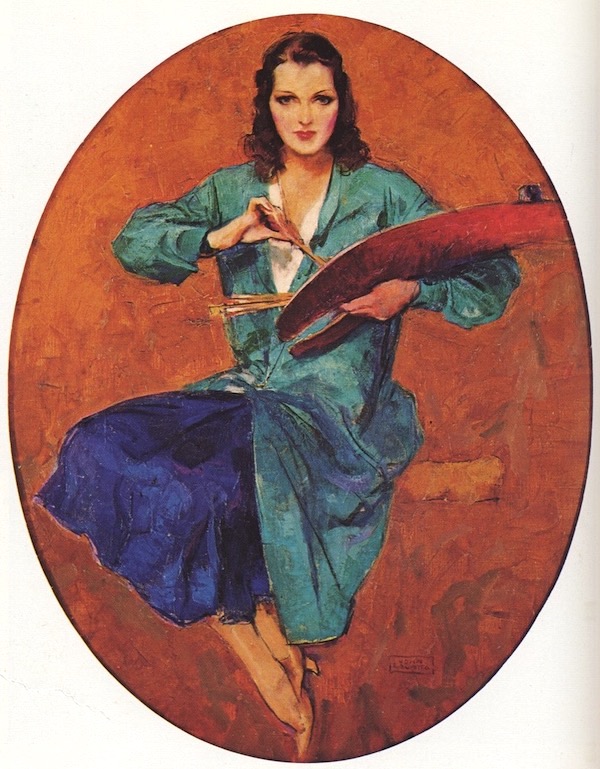








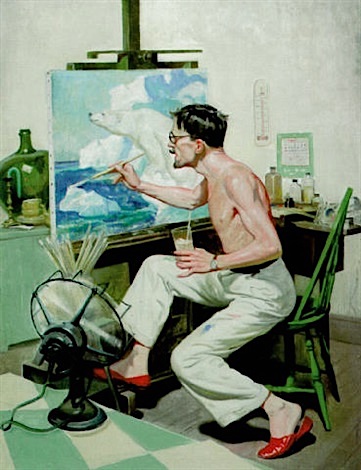










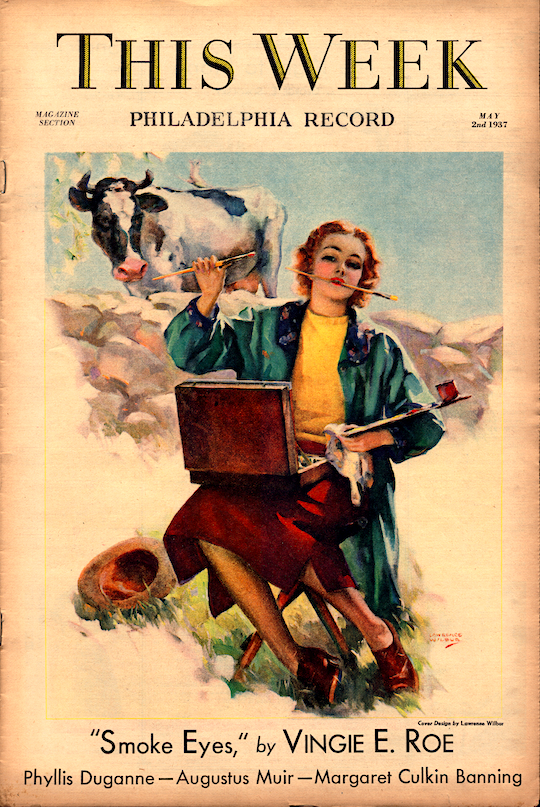




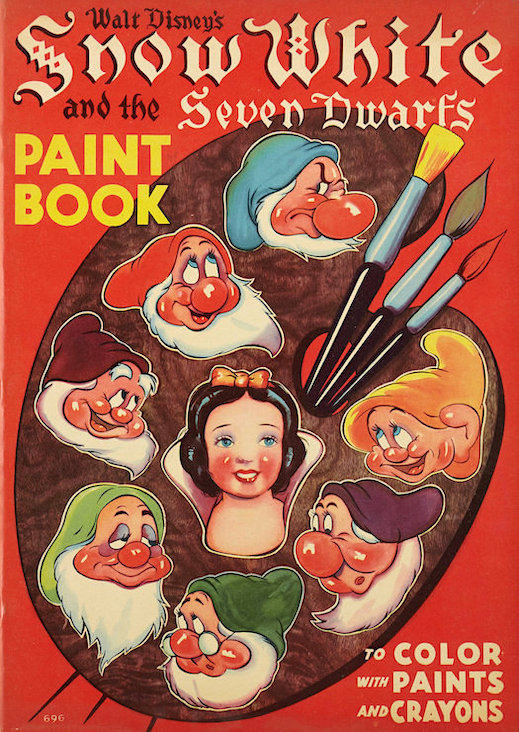







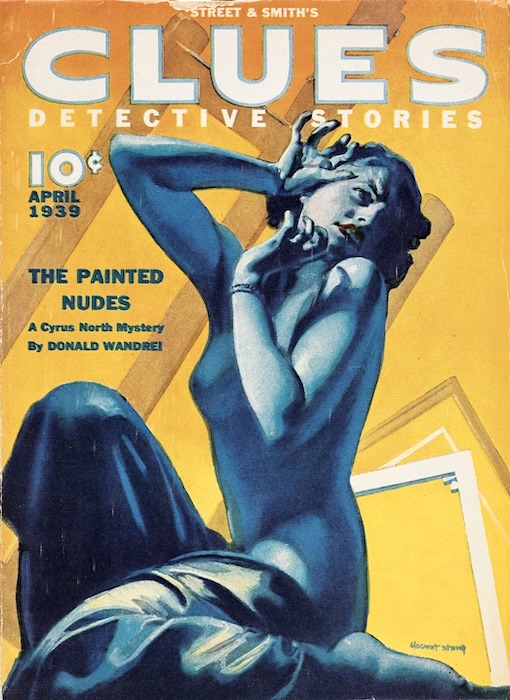
No comments:
Post a Comment